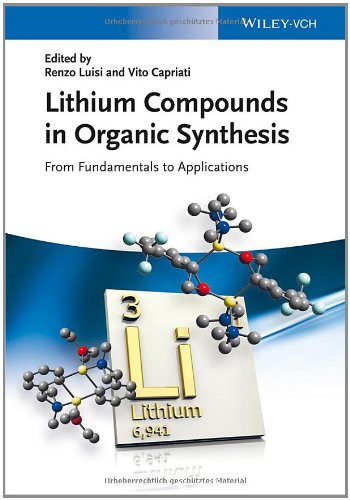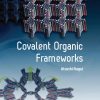(Ebook PDF) Lithium Compounds in Organic Synthesis From Fundamentals to Applications 1st Edition by Luisi Renzo, Capriati Vito ISBN 9783527333431 3527333436 full chapters
$50.00 Original price was: $50.00.$35.00Current price is: $35.00.
(Ebook PDF)Lithium Compounds in Organic Synthesis From Fundamentals to Applications 1st Edition by Luisi Renzo, Capriati Vito-Ebook PDF Instant Download/Delivery:9783527333431, 3527333436
Instant download Full Chapter of Lithium Compounds in Organic Synthesis From Fundamentals to Applications 1st Edition after payment

Product details:
ISBN 10:3527333436
ISBN 13:9783527333431
Author: Luisi Renzo, Capriati Vito
This unique book covers fundamentals of organolithium compounds and gives a comprehensive overview of the latest synthetic advances and developments in the field. Part I covers computational and spectroscopic aspects as well as structure-reactivity relationships of organolithiums, whereas Part II deals with new lithium-based synthetic methodologies as well as novel synthetic applications of functionalized lithium compounds. A useful resource for newcomers and active researchers involved in organic synthesis, whether working in academia or industry!
Table of Contents:
- Part I New Structural Aspects of Lithium Compounds
- Chapter 1 Structure-Reactivity Relationship in Organolithium Compounds
- 1.1 Structural Principles in Organolithium Compounds
- 1.2 Donor-Base-Free Structures
- 1.2.1 Tetramers
- 1.2.2 Hexamers
- 1.2.3 Comparison of [Me3SiCH2Li]6 and [n-BuLi]6
- 1.3 Disaggregation with Lewis Bases
- 1.3.1 Tetramers of Alkyllithium Compounds
- 1.3.2 Asymmetric Aggregates of [Me3SiCH2Li] (4)
- 1.3.3 An Octameric Aggregate of [Me3SiCH2Li]6
- 1.4 Donor-Base-Induced Dimers and Monomers
- 1.4.1 Alkyllithium and Trimethylsilylmethyllithium Compounds
- 1.4.2 PMDETA Aggregated Monomers
- 1.5 Heterobimetallic Organolithium Compounds
- 1.6 Conclusion and Outlook
- References
- Further Reading
- Chapter 2 Computational Perspectives on Organolithiums
- 2.1 Introduction
- 2.2 The Nature of Bonds to Lithium
- 2.3 Aggregation of Lithium Organic Compounds
- 2.4 Solvation Effects
- 2.5 Lithium Alkoxides and Lithium Amides
- 2.6 Computational Studies on Various Organolithium Applications
- 2.7 Conclusion and Outlook
- References
- Further Reading
- Chapter 3 Spectroscopic Advances in Organolithium Reactivity: The Contribution of Rapid-Injection NMR (RINMR)
- 3.1 Introduction
- 3.2 The Curtin-Hammett Principle
- 3.3 Organolithium NMR
- 3.4 Features of RINMR
- 3.4.1 Brief History
- 3.4.2 Apparatus Descriptions and Rapidity of Acquisition
- 3.4.3 Temperature Range and Control
- 3.4.4 Volume Accuracy of Injection
- 3.5 Use of RINMR to Study Organometallic Reactions
- 3.5.1 n-Butyllithium Aggregate Reactivity (1985)
- 3.5.2 Magnesium Chelates in Carbonyl Additions (1987/1990)
- 3.5.3 Lithium Enolate Aldol (1992).
- 3.5.4 Alkyllithium Polymerization (1995/1999)
- 3.5.5 Tin Transmetallation (2007)
- 3.5.6 Cuprates (2002-Present)
- 3.5.7 n-BuLi Aggregate Reactivity Revisited (2007)
- 3.5.8 Tris(trimethylsilyl)methyllithium (2008/2009)
- 3.5.9 Enolization and Lithium Aldol (2011)
- 3.6 Conclusion and Outlook
- References
- Further Reading
- Chapter 4 Spectroscopic Advances in Structural Lithium Chemistry: Diffusion-Ordered Spectroscopy and Solid-State NMR
- 4.1 General Introduction
- 4.2 Application of Solution NMR to the Structural Characterization of Organolithium Compounds
- 4.2.1 Diffusion NMR Measurement Methods
- 4.2.1.1 Pulsed Field Gradient Spin Echo (PFGSE)
- 4.2.1.2 From the First to the Second Dimension: DOSY NMR Experiment
- 4.2.2 DOSY Application to the Structural Analysis of Organolithium Compounds
- 4.2.2.1 Structure of the Mixed Methyllithium/Lithium Chloride Aggregate
- 4.2.2.2 Structure of a Lithium Phosphido-Borane
- 4.2.2.3 Structure of Lithium Zincate
- 4.2.3 Conclusion
- 4.3 Solid-State NMR
- 4.3.1 Basic Principles
- 4.3.1.1 Homo and Heteronuclear Dipole-Dipole Couplings (D: Dipole-Dipole)
- 4.3.1.2 Chemical Shift Anisotropy (CSA)
- 4.3.1.3 Quadrupolar Interactions for Nuclei with I<1/2 (Q)
- 4.3.1.4 Magic Angle Spinning (MAS)
- 4.3.1.5 High-Power Heteronuclear Decoupling
- 4.3.1.6 Cross Polarization
- Hartmann-Hahn Condition
- 4.3.2 Solid-State NMR
- Applications to Organolithium Compounds
- 4.3.2.1 Structure of Lithium Alkyl and Aryl Complexes Stabilized by Nitrogen Ligands
- 4.3.2.2 Symmetry and Geometry of Formed Structures: CIP, SSIP, Sandwich
- 4.3.2.3 Molecular Dynamics
- 4.3.2.4 Reaction Monitoring
- 4.3.3 Conclusion and Outlook
People also search:
what compounds does lithium form
organic lithium compounds
lithium organic
lithium compounds list
lithium compound or element
Tags:
Luisi Renzo,Capriati Vito,Lithium Compounds,Organic Synthesis


